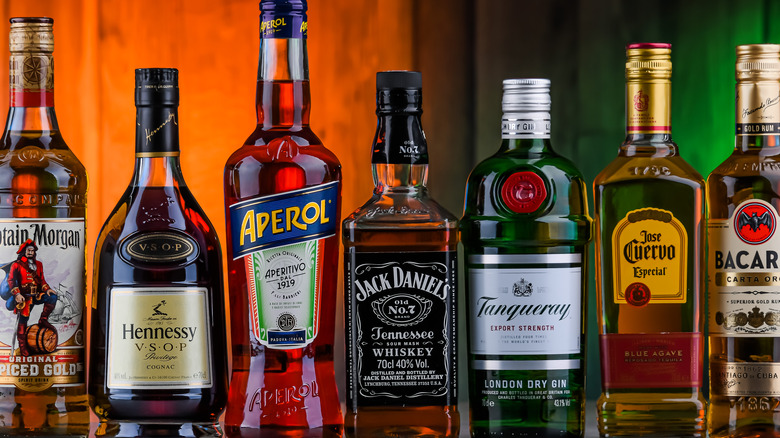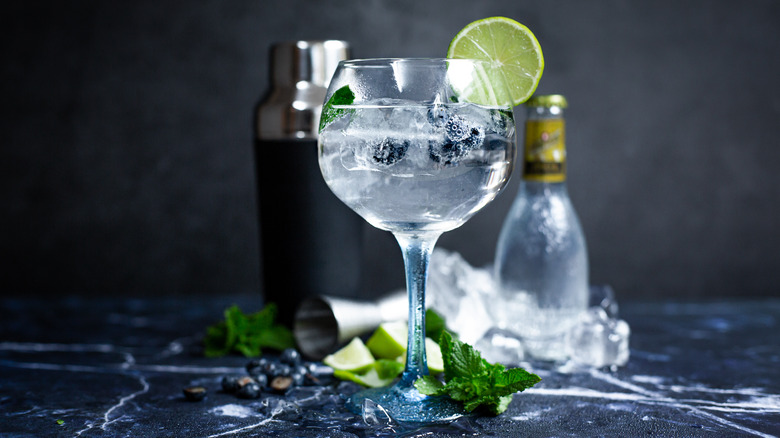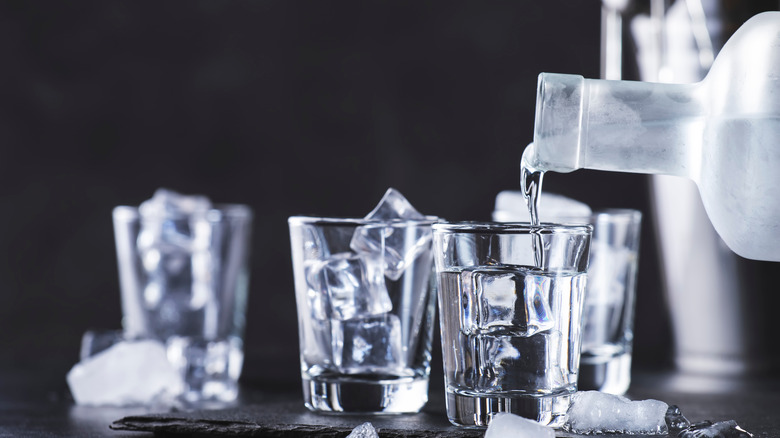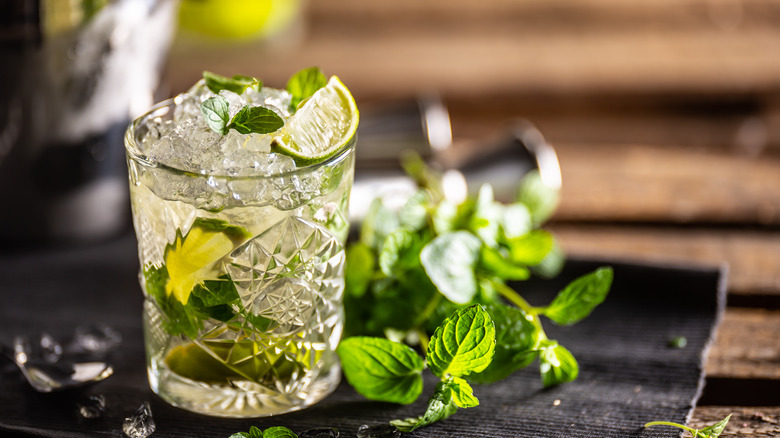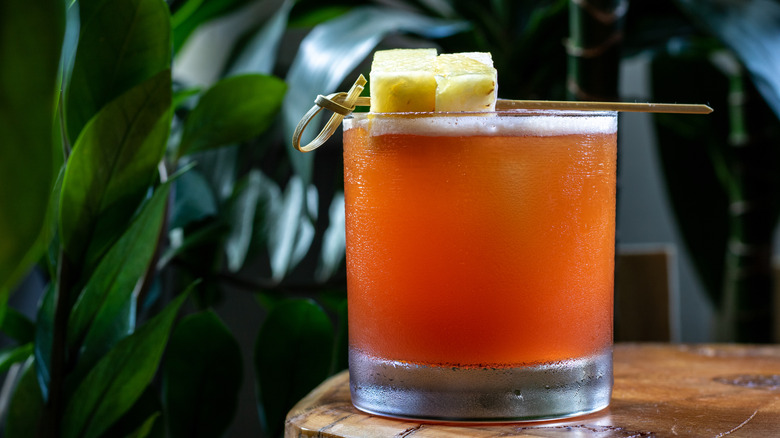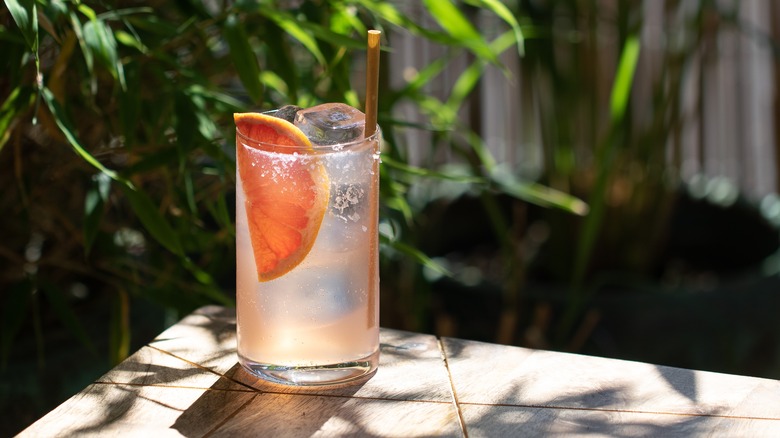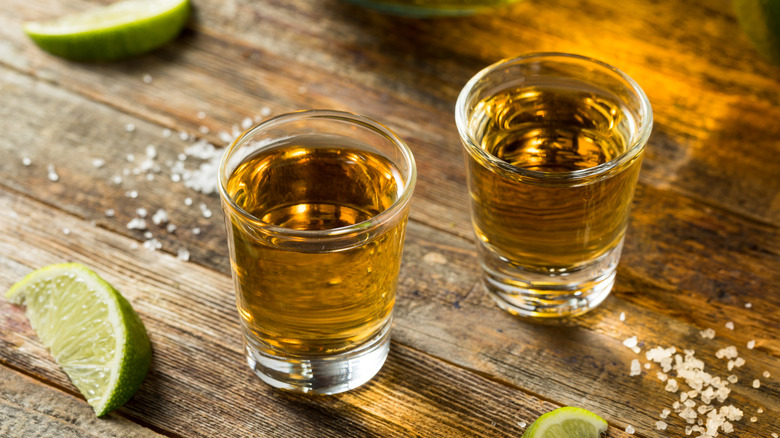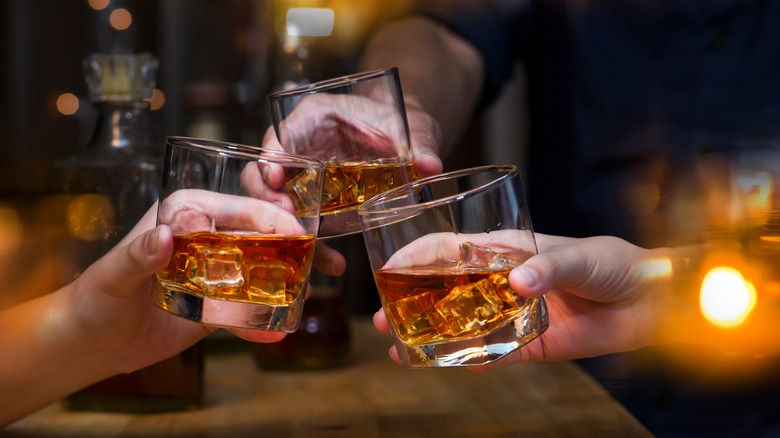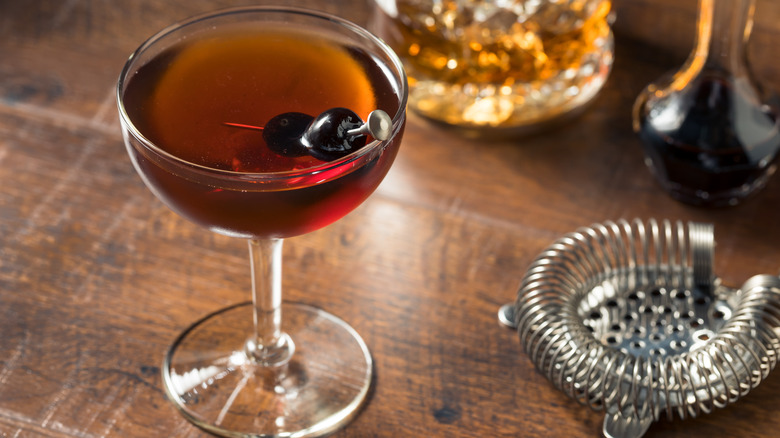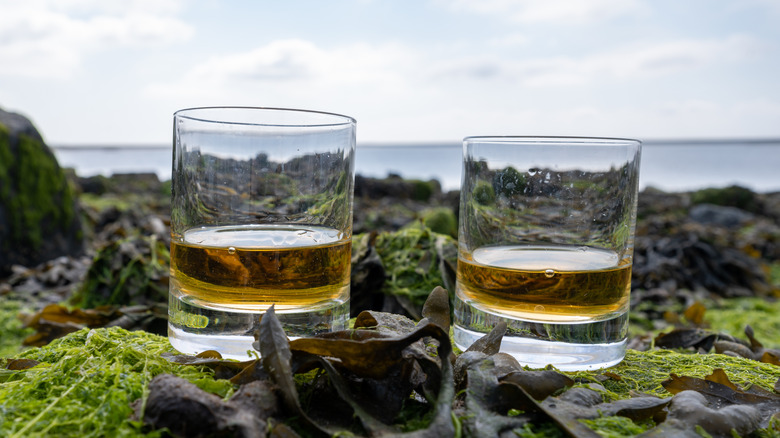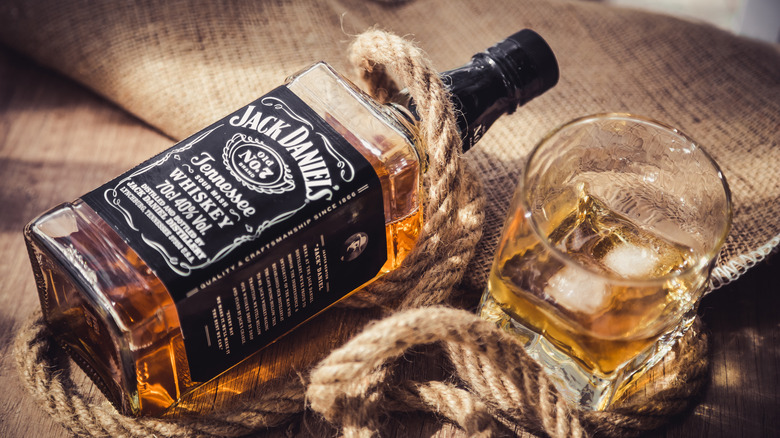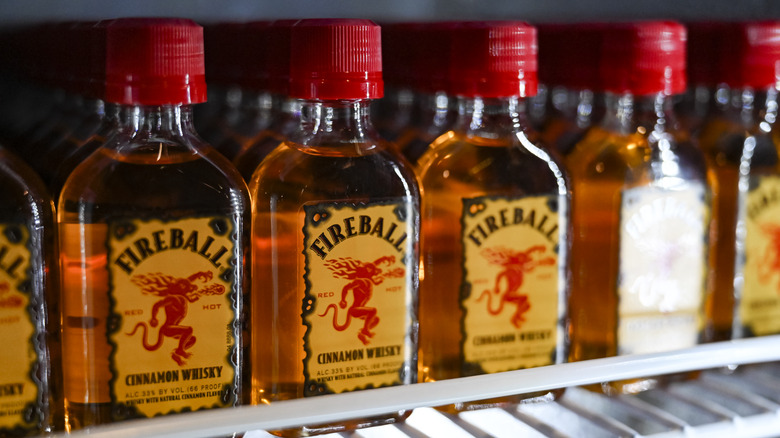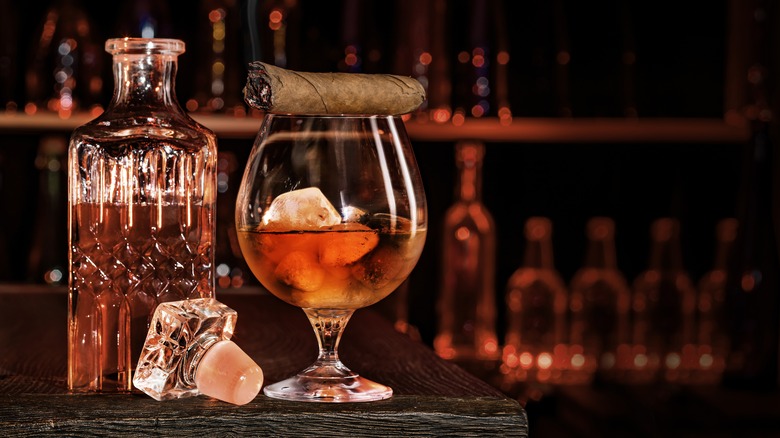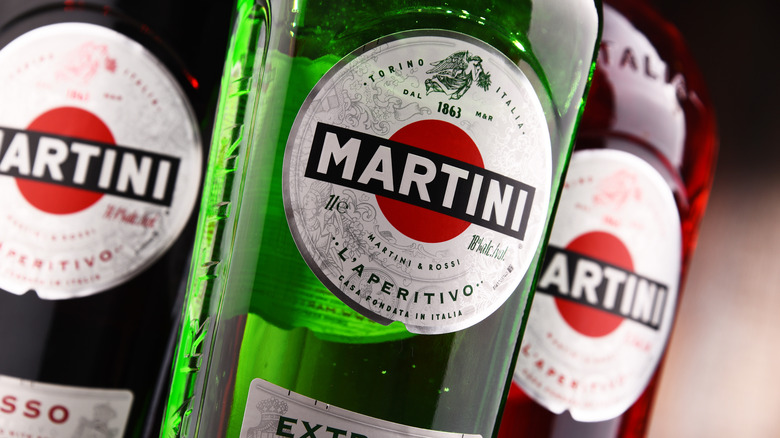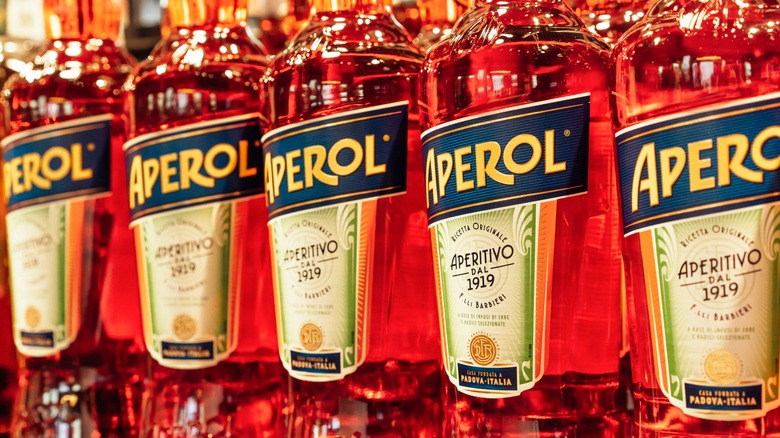13 Liquors Your Home Bar Should Have
If you enjoy entertaining, a well-stocked home bar should be checked off your to-do list before having company over. Of course, people have their go-to drinks and many people may not be liquor drinkers or into very complex or lesser-known cocktails. Regardless, everyone deserves to feel at home when spending time with family or friends, and being given a familiar, favorite drink is a simple, but meaningful gesture that goes a long way toward making someone feel welcome.
Spirits can get expensive, however, and it is understood most people cannot afford to just go out and buy fifteen or more bottles of liquor for their home bar. These are merely suggestions for the basics. The more drinks you try and the more you entertain, you will get a better feeling of what you should have handy going forward. Before you know it, your home bar will be fully stocked. Until then, here is how you can get started.
Gin
If you or someone you know is the person who hates gin, you have certainly not given the spirit a fair chance. Gin is the quintessential cocktail spirit that has been mixed into drinks for over a century. If you were to name a handful of the most iconic cocktails, gin would most definitely be found in more than one. The classic martini, Negroni, Tom Collins, French 75, and tried and true Gin and Tonic are all delicious, gin-based cocktails, and at least one is sure to please you or a guest.
Gin is a fairly straightforward spirit to make, but the ingredients and specific methods used are what separate types of gin and the good from the bad. The spirit is distilled from a grain mash and then distilled again using botanicals. The botanicals are mostly up to the producer's preference, but the only essential botanical to make gin is juniper berry. Juniper is at the forefront of almost every gin, especially London Dry. Other botanicals commonly used to make gin include citrus peel, coriander, angelica root, and other herbs and spices.
Of all the gins on the market, you can't go wrong with a classic London Dry gin, and that means Beefeater. Beefeater London Dry Gin has been distilling gin for almost 200 years and remains the only global gin distributor based in London. It's authentic, inexpensive, straightforward, and reliable.
Vodka
For those particular about minding their calories, or who just prefer a flavorless spirit, you got to have a quality bottle of vodka on your bar. Although it's widely perceived that vodka is only distilled from wheat, vodka can be distilled from just about anything. The three most popular types, however, are wheat, potato, and corn. Because vodka is flavorless, unless flavored artificially, the differences of each type are really only found in their texture and smoothness, per Crafty Bartending. Potato vodka, for example, is known for not having any biting, alcoholic taste, which is why it is largely preferred for cocktails. A corn vodka, such as Tito's, however, is fit for a gluten-free diet if need be.
Although vodka is not as popular in the cocktail world as gin, it does lend itself to some iconic drinks. These include a Kangaroo, or vodka martini, a Cosmopolitan, Moscow Mule, or a White Russian. If you have only ever been exposed to cheap vodka, do your best to try a new brand or style and find a quality, simple bottle suitable for both a vodka-soda or an Espresso Martini.
White rum
Rum is one of the oldest known spirits and it continues to fill the glasses of some cocktail powerhouses. Rum is different from many other spirits because it uses sugarcane for fermentation instead of grain or grapes. The juice from the sugar cane is pressed out and fermented with yeast to produce alcohol. Then, the solution is distilled into the sweet spirit we know and love. White rum is the product of this distillation. Other dark, gold or Jamaican rum get their color from maturation. White rum, however, goes straight to bottling.
This makes for a clean spirit ready to bring refreshments in drinks such as a classic mojito, a daiquiri, or a Piña colada. White rum can also be used in drinks such as a Mai Tai or Cuba Libre, but the type of rum used in those drinks is actually more up to preference.
Rum is produced in many countries, but most rums come from the Caribbean, due to the thriving of sugarcane in the climate. Bacardi is an iconic, standard white rum from Puerto Rico, but other countries in the region, such as Cuba or Haiti, also provide great bottles of the spirit. If you have the chance, find something new that you like and add it to your home bar.
Dark rum
Dark rum undergoes the same distillation process as white rum. The only difference is what happens afterward. White rum is bottled soon after distillation is completed, whereas dark rums are aged inside wooden barrels for an extended period of time. This maturation process is what gives dark rum its color and flavor. Oak barrels are typically used to mature rums, but dark rum is matured specifically in charred oak barrels. This contributes a deeper color and a more complex flavor profile.
As stated earlier, dark rums can be used to make drinks like rum and coke or your preferred Mai Tai, but there are cocktails that call specifically for dark rum. The Dark n' Stormy, for example, is a classic dark rum cocktail and is actually the unofficial drink of Bermuda. Dark rum can also be sipped on its own or used in more spirit-forward cocktails like a rum old-fashioned. The charred barrels impart flavor notes of vanilla and caramel combined with woody notes from the oak.
You may be wondering why you really need two different types of rum for your home bar, which is understood, as alcohol is not always cheap. It is encouraged to have both because there are cocktails that call for both white and dark rum, such as a rum punch. Both Plantation and Diplomatico make an excellent dark rum, but Cruzan will give you the best bang for your buck.
Tequila Blanco
Tequila is booming and there should always be a place on your home bar for a bottle. This spirit, native only to Mexico, is made from the blue agave plant. Agave farmers, known as Jimadors, strip the agave of its leaves and then juice the core by heating and crushing them. The liquid extracted from the agave cores is then fermented and distilled and is then officially tequila. This distillate is tequila Blanco, which, like white rum, is bottled straight after distillation.
Tequila Blanco is an essential bottle to have to make cocktails like Palomas or cocktail variations such as a Mexican Mule or Tequila Negroni. Of course, a classic margarita is always a crowd pleaser and a quality tequila makes a quality cocktail. El Jimador makes a very good tequila blanco as does Espolòn. As much as a celebrity tequila makes for a good conversation piece, many are made with additives and are just generally lower quality.
Tequila Reposado
Just like the difference between white and dark rum, tequila blanco and tequila reposado are made the exact same way. The only difference is what happens to the distillate afterward. "Reposado" means "rested." Like aged rum, tequila reposado rests in oak or white oak barrels. The oak not only darkens the tequila, but it also gives it a softened sweetness that makes the spirit very approachable and easily enjoyed neat. Flavor notes of vanilla dominate and balance exceptionally well with the sweet agave.
While having two different rums on your home bar serves the purpose of the right rum for the right cocktail, the same goes for tequila, but there are a number of other reasons to have both blanco and reposado. There are cocktails that call for blanco and others that call for reposado, yes, but if a guest's favorite drink is a margarita, giving them the option of their preferred style is just another way to enhance your hospitality. Plus, reposado tequilas make for a great sipping spirit as well as an alternative to classic cocktails. For instance, if a guest claims they love an Old Fashioned, you can fix them a Oaxacan Old Fashioned to try with some reposado. El Jimador also makes a fine reposado tequila, and so does Don Julio.
Mezcal
Mezcal is another agave-based spirit that is lesser known, but its spot on your home bar is well-deserved. Mezcal is, however, slowly gaining popularity. As of 2020, the United States received over 371,000 nine-liter cases of the spirit, 67,000 for domestic shipments in Mexico.
Mezcal is made very similarly to tequila. The agave core is isolated, juiced, distilled and then either bottled or matured depending on the type. The key differences are how the agave core is heated and how its juices are distilled. Instead of steaming the agave core, which is the common method in tequila making, the core is fire roasted. The juices pressed out are then distilled in a still made of either clay or wood. These practices are what gives mezcal its smoky finish and depth of flavor.
Cocktails using mezcal are most likely newer inventions that are worth trying, but probably won't be commonly requested. The main reason for mezcal on your home bar is its nuance and general unfamiliarity. Most people you offer a drink to in your home have probably heard of mezcal but maybe have never tried it. Having a bottle handy is a great way to introduce something new to a house guest and share a new experience together.
Montelobos is the great starting point for mezcal before branching out to more unique, more expensive bottles.
Bourbon
The first whiskey on this list is probably the most popular and is certainly the most versatile. Bourbon is used in iconic cocktails like an Old Fashioned, Mint Julep, Bourbon Smash, and possibly someone's preferred Manhattan. Bourbon can bring refreshment in the summer and comfort in the winter. It is also commonly enjoyed neat or on the rocks, so it's best you have a quality bottle handy.
All whiskies come from grain. Types of whiskey are classified differently based on the type of grain as well as the location it is made. Purists will claim bourbon can only be considered bourbon if it is made in the state of Kentucky. Bourbon, however, is an American whiskey, so matter its home state. As far as grain goes, the grain mash used to make bourbon must contain at least 51% corn. The bourbon must be bottled at a proof no higher than 125% and must be aged in charred oak barrels. The high percentage of corn in the mash bill and maturation in charred oak is what gives bourbon its velvety texture, sweeter flavor, and smooth finish.
Maker's Mark Kentucky Straight Bourbon Whiskey is a standard of bourbon and is perfectly fit to be sipped on its own or mixed in a cocktail, and its price point will make you smile too.
Rye whiskey
Just like how bourbon must contain 51% corn in its mash, rye whiskey must contain at least 51% rye grain. Other differences between rye and bourbon include the maximum bottling proof of rye is higher at 160%. Many popular rye whiskies come from Canada, but the geographical requirements for rye whiskey are not stringent. Whistlepig makes an excellent rye 10-year rye whiskey if you don't mind splurging a bit on a great bottle. If you only see yourself using your rye for cocktails, Old Overholt comes in at around $20 a bottle.
Rye whiskey is not as popular in the world of cocktails as bourbon, but the original Manhattan is a rye drink. Rye whiskey can be found in the Negroni variation, the Old Pal, as well as New Orleans' own cocktail, a Sazerac. It can be used to make an Old Fashioned if that's your preference or in a Boulevardier. Again, even if you rarely drink rye whiskey, yourself, it's always a nice touch to be able to give houseguests the option.
Scotch whisky
The geographical restrictions for scotch are probably the most strict. It's only scotch if it comes from Scotland, and there are a variety of scotch styles within Scotland, all of which contribute to different flavor profiles.
Styles of scotch are divided into Highland, Lowland, Speyside, Islay, Campbelton, and Islands. For example, the Scottish Highlands produce the most scotch of any other region, so, depending on what part of the Highlands a scotch comes from, it will most likely be sweeter and richer. Islay scotches are known for their intense peat and smokiness. These are more for the experienced scotch drinker and probably not best for beginners.
Scotches can also be broken up into single-malts, meaning they are made with only one type of barley at one distillery, single-grains, which are made of a combination of barley and cereal grain, and blended, which are mixtures of both.
The one thing about scotch is that quality bottles are expensive, mostly because they are imported from the United Kingdom. Trying scotches from different regions is a great way to diversify your liquor collection and discover new spirits and bottles, but if you are new to scotch and just want to have a bottle on your bar to cater to guests, a simple bottle of Johnnie Walker Black Label is sure to keep any scotch drinker pleased. Plus, this blended scotch is best for mixing cocktails.
Tennessee whiskey
Tennessee whiskey really only means one thing, and that's Jack Daniels. Jack Daniel's is one of the most iconic bottles of liquor around, and although it may not be a favorite spirit of bartenders or cocktail enthusiasts, the chances someone you are entertaining likes it is bigger than you think.
Whether it's a night-out classic, like Jack and Coke, or just shots of the stuff to get a night out started, Jack Daniel's belongs on your bar because every guest deserves to have their go-to drink available to them. Jack Daniel's isn't the only Tennessee whiskey on the market, however, and if you like Jack Daniel's, venturing out into other bottles is encouraged.
Although Jack Daniel's is technically a bourbon due to its mash bill containing 51% corn, there are production methods that separate Tennessee whiskey from bourbon. The spirit is aged in newly charred American oak barrels but is filtered through sugar maple charcoal beforehand. This gives the whiskey its softer, more subdued taste and its recognizable flavor notes. Plus, Tennessee whiskey is made with a sour mash bill. Where bourbon is made with all new grain, sour mashes are a blend of spent mash and new mash, which aids in fermentation.
Flavored whiskey
Some people find their drink in college and stick with it. If it ain't broke, don't fix it. Flavored whiskey is definitely not something you'll need for any classic cocktail, but liquors like Fireball Cinnamon Whiskey are so popular, it's best you have a bottle handy. Other flavored whiskies like Skrewball Peanut Butter Whiskey and variations by established brands like Apple Jack or Jim Beam Honey are also popular.
Flavored whiskies can actually be a fun way of upping the festiveness of a cocktail. For example, if you like a classic Old Fashioned, try making one with pumpkin whiskey or maple bourbon. In the wintertime, get cozy with a glass of chocolate whiskey or add a splash to your hot cocoa. Flavored whiskey may seem like a novelty, but the wide variety on the market should be a testament to its popularity. As always, it may not be for you, but it may be for a guest, and if you like entertaining, you'll want to be prepared to make anyone feel at home.
Brandy
You've definitely heard of brandy, but you may not know exactly what it is. Brandy is distilled from wine, and gets its name from the dutch word "brandewijn," which means "burnt wine." In the 16th century, French wine was uber popular and the Dutch were keen on buying it in lots and distributing it globally. However, the wine was difficult to ship and did not travel well, so, in order to make the wine more space efficient, they decided to distill it down to decrease its volume. This boosted the wine's alcohol content and turned common wine into a delicious, fortified spirit that has sustained since.
The most popular type of brandy is Cognac, but a brandy can only be considered a Cognac if it is made with grapes from the Cognac region of France. Other popular brandy styles include Armagnac, Pisco, and Grappa.
There are delicious cocktails made with brandy such as a Sidecar or a Vieux Carre, and the spirit is a common substitute for whiskey in drinks like a Brandy Manhattan or Brandy Old Fashioned. Brandy is also, and probably most commonly, enjoyed on its own as an after-dinner libation. Brandy is silky smooth and wonderfully sweet and is the perfect way to round out a meal and kick your digestion into gear. A quality bottle of brandy is a must on your home bar and you can't go wrong with Hennessy or Gran Marnier.
Mixers and garnishes
You can have a wide variety of liquor, but if you like mixing cocktails or want to get into doing so, those bottles won't mean much without mixers. The most essential mixers for your home bar are vermouth and bitters.
Vermouth is a fortified wine, meaning a wine that is strengthened, usually with brandy or another neutral spirit. Once the wine is strengthened, herbs, spices, roots, or a combination of all three are added to balance the vermouth and add more depth of flavor. Vermouth can be divided into dry and sweet. Dry vermouth is made from white wine, and sweet, or red, vermouth is made from red wine. Vermouth is required for an endless amount of cocktails ranging from classics as iconic as a Martini to modern revelations. Your home bar is not complete without a bottle of dry and a bottle of sweet.
Bitters are another requirement for countless cocktails. These tiny, inexpensive bottles are essentially cocktail seasonings. They enhance the flavors of other spirits and liqueurs and help tie everything together. Bitters are extractions from infused alcohol. Bitters can be made from just about anything, but the most common and useful types of bitters you should have handy are aromatic bitters and orange bitters.
Liqueurs and cordials
If you want to be able to make a multitude of cocktails for yourself and guests, a variety of liqueurs is just about as essential as vermouth and bitters. Popular liqueurs commonly used in cocktails are Campari, Aperol, triple-sec, chartreuse, and coffee liqueur, to name a few.
The great thing about liqueurs, other than their contribution to delicious drinks, is they can be enjoyed on their own as pre-dinner or after-dinner drinks. Because liqueurs typically have a lower ABV, sipping on one before or after dinner is not only a tasty way to begin or end an evening, it is a helping hand to your gut health. Sipping on an aperitif or digestif actually triggers your digestive cycle and aids in a more stable, swift breakdown of your meal.
You certainly don't need to buy every liqueur your local liquor store has to offer, but the more cocktails you try and the more you develop your taste, the better you will know what you need and what you don't. Space is finite in your home bar and the less wasted space there is, the better.
